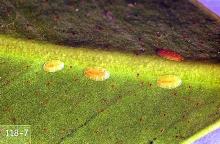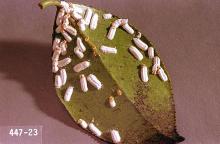Pulvinaria floccifera
Pest description and damage Scale insects are small (less than 0.125 inch in length) soft insects that live beneath waxy scales. These insects are often identified by the shape and size of their scales, the description of adult males and females, immature crawler stage, color of eggs, and host plant preferences. The most visible stage of the cottony camellia scale insect is the adult female that resembles a flat, 0.125-inch diameter scale often found on the underside of a leaf. Emerging from beneath the adult female is an oblong cottony white egg mass that can be up to twice the length of the adult scale. The cottony camellia scale (sometimes called taxus scale) crawlers are flat brownish or yellowish sucking insects. Foliage with scale infestations may turn yellowish or pale in color. Due to copious honeydew, leaves below are covered with a crust of black sooty mold. The cottony camellia scale also is found on English ivy, yew, euonymus, holly, hydrangea, maple, mulberry, pittosporum, rhododendron, and yew. It is possible to have low numbers of this insect for years without an outbreak.
Biology and life cycle This scale overwinters as nymphs on twigs of the leaves. In the spring, adult females lay cottony egg masses about 0.25 inch long on the underside of leaves. The eggs hatch, and the crawlers settle on the leaves along the veins to feed. There is one generation per year.
Pest monitoring Look for scale insects on the undersides of leaves above surfaces covered with honeydew and black sooty mold. Host plants may have continuous low numbers of scales or be patchy in distribution on the plant. Check for natural enemies, or evidence of parasitized scales.
Management-biological control
Small birds and parasitoids feed on the scale insects. It is likely that natural enemies account for the low number of scales year after year on observed plants. Low numbers of cottony camellia scale do little harm to plants but provide parasitoids with a steady source of prey. Periodically, an outbreak of this scale may require control.
Management-chemical control
See Table 1 in:
Chemical Control of Landscape Pests
For more information
See "Scale insect" in:




